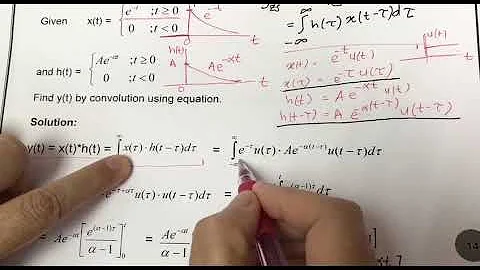Convolution along one axis only
Solution 1
You can use np.apply_along_axis to apply np.convolve along the desired axis. Here is an example of applying a boxcar filter to a 2d array:
import numpy as np
a = np.arange(10)
a = np.vstack((a,a)).T
filt = np.ones(3)
np.apply_along_axis(lambda m: np.convolve(m, filt, mode='full'), axis=0, arr=a)
This is an easy way to generalize many functions that don't have an axis argument.
Solution 2
With ndimage.convolve1d, you can specify the axis...
Solution 3
np.apply_along_axis won't really help you, because you're trying to iterate over two arrays. Effectively, you'd have to use a loop, as described here.
Now, loops are fine if your arrays are small, but if N and P are large, then you probably want to use FFT to convolve instead.
However, you need to appropriately zero pad your arrays first, so that your "full" convolution has the expected shape:
M, N, P = 4, 10, 20
A = np.random.randn(M, N)
B = np.random.randn(M, P)
A_ = np.zeros((M, N+P-1), dtype=A.dtype)
A_[:, :N] = A
B_ = np.zeros((M, N+P-1), dtype=B.dtype)
B_[:, :P] = B
A_fft = np.fft.fft(A_, axis=1)
B_fft = np.fft.fft(B_, axis=1)
C_fft = A_fft * B_fft
C = np.real(np.fft.ifft(C_fft))
# Test
C_test = np.zeros((M, N+P-1))
for i in range(M):
C_test[i, :] = np.convolve(A[i, :], B[i, :], 'full')
assert np.allclose(C, C_test)
Solution 4
for 2D arrays, the function scipy.signal.convolve2d is faster and scipy.signal.fftconvolve can be even faster (depending on the dimensions of the arrays):
Here the same code with N = 100000
import time
import numpy as np
import scipy.signal as sg
M, N, P = 10, 100000, 20
A = np.random.randn(M, N)
B = np.random.randn(M, P)
T1 = time.time()
C = sg.convolve(A, B, 'full')
print(time.time()-T1)
T1 = time.time()
C_2d = sg.convolve2d(A, B, 'full')
print(time.time()-T1)
T1 = time.time()
C_fft = sg.fftconvolve(A, B, 'full')
print(time.time()-T1)
>>> 12.3
>>> 2.1
>>> 0.6
Answers are all the same with slight differences due to different computation methods used (e.g., fft vs direct multiplication, but i don't know what exaclty convolve2d uses):
print(np.max(np.abs(C - C_2d)))
>>>7.81597009336e-14
print(np.max(np.abs(C - C_fft)))
>>>1.84741111298e-13
Related videos on Youtube
Paul
Updated on May 23, 2022Comments
-
Paul almost 2 years
I have two 2-D arrays with the same first axis dimensions. In python, I would like to convolve the two matrices along the second axis only. I would like to get
Cbelow without computing the convolution along the first axis as well.import numpy as np import scipy.signal as sg M, N, P = 4, 10, 20 A = np.random.randn(M, N) B = np.random.randn(M, P) C = sg.convolve(A, B, 'full')[(2*M-1)/2]Is there a fast way?
-
Paul about 13 yearsThanks for pointing that out. The 'weights' argument, however, needs to be 1-D. It is 2-D in my case.
-
endolith about 10 yearsdoes this have any speedup vs a loop along each row?
-
Praveen over 7 years@endolith Nope, it doesn't. See this answer...
-
Praveen over 7 years
np.apply_along_axisreally can't be used here, since the OP wants it to iterate over two arrays. The way to do that is to simply use a loop, as described here.









![[DL] The purpose of "1 by 1" convolutions](https://i.ytimg.com/vi/W4BrS66HnNQ/hq720.jpg?sqp=-oaymwEcCNAFEJQDSFXyq4qpAw4IARUAAIhCGAFwAcABBg==&rs=AOn4CLDioB9RgYdMfUH4-teWAG1rfy6rrw)
